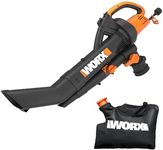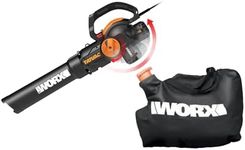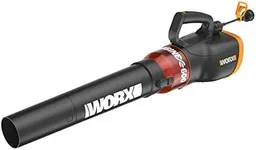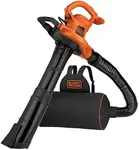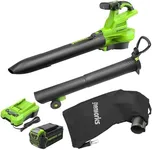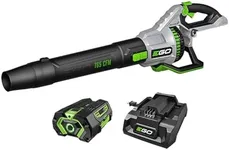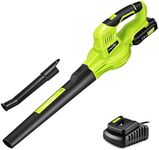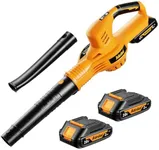Buying Guide for the Best Most Powerful Leaf Vacuums
Choosing the right leaf vacuum can make your yard work much easier and more efficient. When selecting a leaf vacuum, it's important to consider several key specifications to ensure you get the best fit for your needs. Understanding these specs will help you make an informed decision and find a leaf vacuum that suits your yard size, type of debris, and personal preferences.Power SourceLeaf vacuums can be powered by electricity (corded or cordless) or gasoline. Electric models are generally quieter and lighter, making them suitable for smaller yards and lighter tasks. Cordless models offer more mobility but have limited battery life. Gas-powered models are more powerful and can handle larger areas and tougher debris, but they are heavier, noisier, and require more maintenance. Choose based on the size of your yard and the type of debris you need to handle.
Motor PowerMotor power is measured in amps for electric models and cubic centimeters (cc) for gas models. Higher motor power means more suction and blowing capability. For small to medium yards with light debris, a motor with lower power (around 8-12 amps or 20-30 cc) may suffice. For larger yards or heavy, wet debris, look for higher power (12+ amps or 30+ cc). Consider the typical conditions of your yard to determine the right motor power for you.
Airflow and AirspeedAirflow (measured in cubic feet per minute, CFM) and airspeed (measured in miles per hour, MPH) determine the vacuum's ability to move and collect leaves and debris. Higher CFM and MPH values indicate better performance. For light tasks, a CFM of 200-300 and an MPH of 100-150 may be adequate. For heavy-duty tasks, look for CFM values above 300 and MPH above 150. Match these specs to the type of debris and the size of your yard.
Mulching RatioThe mulching ratio indicates how finely the vacuum can shred leaves and debris. A higher ratio means finer mulch, which is better for composting and reduces the volume of collected debris. Common ratios range from 10:1 to 18:1. If you plan to use the mulch for composting or want to minimize the number of trips to empty the bag, opt for a higher mulching ratio. Consider your disposal and composting needs when choosing this spec.
Bag CapacityBag capacity refers to the volume of debris the vacuum can hold before needing to be emptied. Larger capacities mean fewer interruptions but can make the vacuum heavier and harder to maneuver. Capacities typically range from 10 to 20 gallons. For smaller yards, a smaller capacity may be sufficient, while larger yards or heavy leaf fall may require a larger capacity. Think about the size of your yard and how often you want to empty the bag.
Weight and ErgonomicsThe weight and design of the leaf vacuum affect how easy it is to use. Lighter models are easier to carry and maneuver, especially for extended periods. Ergonomic features like padded handles and adjustable straps can enhance comfort. If you have a large yard or will be using the vacuum for long periods, prioritize lighter models with good ergonomics. Consider your physical strength and comfort preferences when evaluating this spec.
Noise LevelNoise level is an important consideration, especially if you live in a neighborhood with noise restrictions or prefer a quieter operation. Electric models are generally quieter than gas models. Noise levels are measured in decibels (dB), with lower values indicating quieter operation. If noise is a concern, look for models with noise levels around 60-70 dB. Consider your environment and personal preference for noise when choosing a leaf vacuum.

